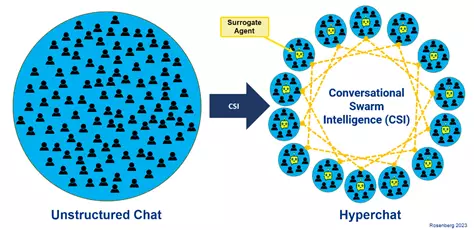As workplaces evolve, so do the demands for innovative collaboration methods. Traditional brainstorming sessions often fall short when the number of participants swells beyond a manageable capacity. The typical structure of group discussions might yield promising ideas in small settings, but what happens when collaboration is scaled up to accommodate massive teams? The inherent challenge lies in the diminishing returns of productivity, where larger groups frequently devolve into miscommunication and chaos. However, a breakthrough technology known as conversational swarm intelligence—or hyperchat—promises to change the game by enabling vast teams to collaborate effectively in real time, driving towards AI-optimized solutions.
Hyperchat: Redefining Group Dynamics
Hyperchat functions by cleverly navigating the complexities associated with large group dynamics. Unlike conventional group discussions that can become unwieldy as they grow beyond a handful of participants, hyperchat intelligently segments large teams into smaller, manageable subgroups. Each subgroup is aided by an AI-powered “conversational surrogate,” which actively listens to the contributions of human participants to distill key insights. These surrogates facilitate seamless exchanges of information across subgroups, weaving their discussions into a cohesive dialogue.
This innovative setup offers a stark contrast to traditional methods. Instead of a cacophony of overlapping voices, hyperchat provides structured yet fluid conversations that promote high levels of engagement and creativity. Imagine a team of 200 individuals, each with unique insights and expertise, but now working in symphonic harmony rather than disparate notes. Hyperchat represents not merely an advancement in group discussions but a transformation in how we think about collaborative intelligence.
A Real-World Test of Efficacy
To assess its effectiveness, Unanimous AI conducted an experiment involving 50 sports fans tasked with creating a March Madness bracket via the Thinkscape platform, which facilitates hyperchat. Conventional wisdom suggests that large groups struggle to maintain productive interactions, yet preliminary results indicate otherwise. The collaborative bracket generated by this diverse group of sports enthusiasts not only demonstrated remarkable results but was also entered in the ESPN March Madness contest. Astonishingly, it performed in the 99th percentile among 30 million competitors.
These outcomes raise intriguing questions: Could hyperchat be an underutilized tool for tapping into the collective intelligence of large groups? Early indications suggest an affirmative response, revealing that effectively harnessing diverse thoughts can elevate collective capabilities above individual contributions. As the sporting events unfold, the anticipation of how these hyperchat-generated brackets will match up against individual choices keeps the excitement alive.
Unveiling the Potential of Hybrid Intelligence
The implications of hyperchat extend beyond sports brackets and other simple organizational tasks. An important aspect of this technology is its potential to merge human intelligence with artificial intelligence, allowing hybrid groups to tackle complex challenges in unprecedented ways. By integrating a second layer of AI agents known as “contributor agents,” hyperchat can facilitate real-time access to factual information for ongoing discussions, capturing the essence of a collective superintelligence.
Studies illustrate dazzling improvements in group performance when using hyperchat versus regular chat platforms. Participants have reported heightened productivity and collaboration while feeling a greater sense of ownership over the decisions being made. This empowerment can breathe new life into motivation and engagement, which is often lacking in traditional formats.
Addressing Collaboration Bottlenecks
As organizations increasingly grapple with communication bottlenecks, hyperchat emerges as a promising solution. For Fortune 1000 companies, often consisting of thousands of employees split into large functional teams, the need for an efficient real-time deliberation system is evident. Business leaders can foster a climate where ideas flow freely and every voice is heard, regardless of the group’s size.
The transformation enabled by hyperchat isn’t just about efficiency; it embodies a visionary approach to decision-making. By nurturing a larger, more engaged conversation, organizations can better capitalize on the full spectrum of insights available. As we move into an era where teamwork is vital for success, harnessing hyperchat could unlock untapped potential within diverse groups.
Looking Ahead: A New Era of Collaboration
The early evidence surrounding hyperchat is encouraging, suggesting that we are on the brink of something transformative in the realm of collaboration. As we continue to witness sports fans and professional teams alike leveraging this technology, the potential for lasting change in how we collaborate is clearer than ever. By embracing tools like hyperchat, organizations can navigate the complexities of collective intelligence, ushering in a new age of more intelligent, agile, and inclusive decision-making. The future of collaboration is not just about managing large groups; it’s about maximizing the power of their collective insights to achieve extraordinary outcomes.

